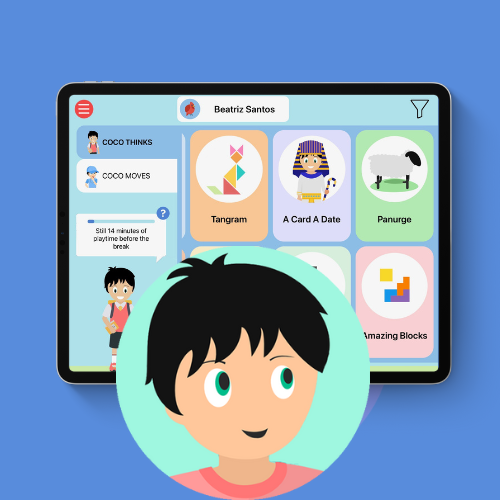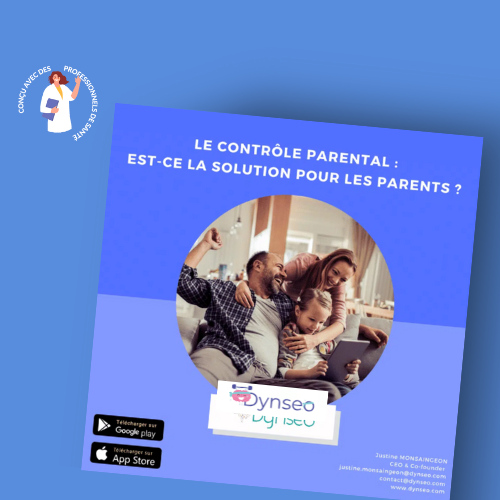The importance of age-appropriateness in the use of social networks
Children’s access to social networks is a growing concern for many parents. Understanding the importance of respecting age restrictions and ensuring that children are mature enough to navigate these platforms is crucial to their online safety. Here’s a detailed exploration of these aspects.
a) Age restrictions on social media platforms
Implementing age restrictions: Most social media platforms, such as Facebook, Instagram, Snapchat, and TikTok, require users to be at least 13 years old to create an account. These restrictions are based on laws such as the Children’s Online Privacy Protection Act (COPPA) in the USA, which aims to protect the privacy of children under 13.
Role of parents: It’s imperative that parents are proactive in checking the age policies of platforms and ensuring that their children respect these limits. This often involves discussing potential risks with children and supervising their enrolment in these services.
Consequences of non-compliance with age restrictions: When children circumvent age restrictions, they expose themselves to inappropriate content and potentially dangerous interactions with adults or ill-intentioned peers. What’s more, this can make them more vulnerable to cyberbullying and other forms of online manipulation.
b) Why kids should wait until they’re mature enough to use social networks
Understanding the risks: Responsible use of social networks requires an understanding of the associated risks, such as disclosure of personal information, cyberstalking and exposure to harmful content. Children who are not mature enough may not recognize or know how to handle these situations.
Time management and autonomy: Children need to learn how to manage their online time effectively to avoid problems such as distracted homework or negative impact on sleep. Parents play an essential role by setting clear rules about time spent online, and teaching children the importance of balancing digital life with offline activities.
Social skills development: Face-to-face interactions are crucial to the development of social skills in young people. Too much time spent on social networks can limit these essential interactions. Children should be encouraged to cultivate real-world relationships to strengthen their emotional intelligence and their ability to interact empathetically and respectfully.
Assessing maturity: Before allowing their children to use social networks, parents need to assess their ability to understand and respect privacy rules, identify and report inappropriate behavior, and resist online peer pressure. This can involve ongoing discussions and guidance on good online practice.
The appropriate age to start using social networks depends on several factors, including the child’s maturity, understanding of online risks, and ability to manage time and interactions. Parents need to be active guides and role models for their children when it comes to online safety, setting clear rules and engaging in open dialogue about the benefits and challenges of social networking. By doing so, they can help their children to navigate more safely and responsibly in the digital space.
The most popular social networks for children
The use of social networks varies considerably according to the age of users, with each platform having characteristics that attract specific age groups. Here’s an overview of the social networks preferred by young people and how their preferences can differ depending on their age:
Children’s favorite social networks (8-12 years)
YouTube Kids: Specially designed for children, YouTube Kids offers a safer environment for young users. It lets kids explore their interests through videos on a variety of themes, while offering parents controls to limit the content they can access.
Roblox and Minecraft: Although primarily gaming platforms, Roblox and Minecraft have significant social components. Children can create, play and interact with others in virtual worlds, developing creativity while learning the basics of online communication.
Favored Social Networks of Teenagers (13-17 years)
Instagram and Snapchat: These platforms are extremely popular among teenagers for their ability to share photos and videos, offering expressive and immediate means of visual communication. Snapchat, in particular, is popular for its ephemeral messages that disappear after being viewed, attracting a younger audience in search of more spontaneous and private conversations.
TikTok: Quickly becoming a favorite among teenagers, TikTok lets users create and share short music videos. Its playful nature and easy-to-consume format make it a prime platform for creative expression among young people.
Favored Social Networks of Young Adults (18-24)
Twitter and Reddit: With a stronger focus on current affairs, politics and specific hobbies, Twitter and Reddit attract young adults interested in discussing and exchanging ideas on a variety of topics. These platforms also make it possible to track trends and news on a global scale.
LinkedIn: Although primarily a professional platform, LinkedIn is gaining in popularity among young adults entering the professional world. It allows you to network, search for career opportunities and share professional achievements.
Preference for certain social networking platforms varies with age due to changes in interests, communication habits and social needs. For parents, understanding these preferences and the behaviors associated with each platform can help guide their children towards safe and responsible use of social networks. This includes not only monitoring and controlling access, but also educating children and teenagers about best practices for each type of platform they choose to use.
b) Risks associated with each platform
Instagram can expose children to inappropriate images and social pressure to look perfect. Snapchat can make it easy to share ephemeral content, but it can also lead to irresponsible or dangerous behavior. TikTok can expose children to inappropriate content and dangerous challenges. Parents need to be aware of these risks and monitor their children’s online activity.
How can we protect children on social networks?
Protecting children on social networks requires a multidimensional approach. This strategy includes implementing parental controls, educating children about online safety, and promoting open communication between parents and children. Here’s how each element can be strengthened to better protect young users online.
a) Parental control and supervision
Advanced parental control tools: In addition to basic parental control features, there are advanced software and applications that offer detailed options such as content filtering, tracking of downloaded applications, and even real-time localization. These tools enable parents to personalize restrictions according to the child’s age and maturity.
Scheduling screen time: It’s advisable to set specific times when children can access social networks, thus limiting their exposure. This practice helps to establish a healthy routine and prevent overuse, which can affect sleep and school performance. With our app Coco Thinks and Coco Moves, the scheduling screen time is mandatory, with a break imposed every 15 minutes of screen time.
Proactive monitoring: Beyond passive monitoring, it’s beneficial for parents to take a proactive approach by participating in or discreetly monitoring children’s online activities. This can include the creation of joint accounts or monitoring by apps that alert parents to suspicious activity.
b) Raising children’s awareness of online safety
Interactive educational programs: Using interactive programs and games that teach online safety in an engaging way can increase children’s receptiveness. These tools can cover topics such as recognizing fake profiles, understanding privacy settings, and techniques for securing passwords.
Scenarios and simulations: Organize sessions where children can practice responses to potentially dangerous situations on social networks. This could include simulations of phishing attempts or friend requests from strangers, teaching them to react appropriately.
Ongoing dialogue: Make online safety a regular topic of conversation, not a taboo. Talking about it frequently raises children’s awareness and prepares them to handle situations more confidently on their own.
c) Encouraging open communication
Creating an environment of trust: Children need to feel comfortable talking about anything to do with their online lives without fear of judgment or punishment. This includes setting up regular “chat times” where they can share their experiences online.
Learn the warning signs: Educate children about the warning signs of online manipulation or harassment, and encourage them to speak up immediately. Parents need to be trained to recognize these signs themselves.
Partnerships with schools: Work with schools to ensure that children receive consistent online safety education at home and at school. Schools can be valuable partners in online safety education, offering additional resources for parents.
By implementing these practices, parents can not only better protect their children from the dangers of social networking, but also equip them to navigate the digital world independently and safely.
Safety tips for parents of children using social networks
To guarantee children’s safety on social networks, it’s essential for parents to implement a well-thought-out strategy and adopt proactive measures. Here are detailed tips to help parents navigate this crucial aspect of modern parenting.
a) Tips for keeping children safe on social networks
Setting Ground Rules: It’s crucial to establish ground rules for using social networks. This can include limits on the types of platforms allowed, the age at which they can start using them, and the hours during which they can access them. Clearly explain these rules and the consequences of breaking them, to reinforce their importance.
Parental Controls: Use parental control tools to monitor and restrict access to online content. These tools can help filter out inappropriate content, limit time spent online, and monitor interactions to ensure they remain in a safe environment.
Online Safety Education: Educate your children about the risks associated with using social networks, including sharing personal information, dealing with friend requests from strangers, and recognizing potential scams. Making these discussions regular can help children internalize safety practices.
b) The importance of setting limits and rules
Developing Common Understanding: It’s important that children understand why these rules and limits are in place. Explain that these measures are designed to protect them from potential dangers and ensure a positive and safe online experience.
Consistency in Application: Rules are only effective if they are applied consistently. Parents should be sure to regularly monitor their children’s use of social networks and discuss any deviations from the rules. This includes taking appropriate disciplinary action if the rules are broken.
Involve children in the process: When setting the rules, involve your children in the dialogue. Let them express their opinions and concerns. This can help create rules that are not only fair, but also more likely to be respected, as children will feel part of their development.
The key to keeping kids safe on social networks lies in a mix of education, monitoring and open communication. By setting clear rules, using parental control tools, and engaging in regular discussions about online safety, parents can create a safe digital environment for their children while strengthening family bonds through mutual understanding and trust.
The risks of cyber bullying on social networks

Cyber bullying represents a major and growing challenge for children and teenagers in today’s digital environment, particularly with the increasing use of social networks. To combat this phenomenon effectively, it is essential to understand not only what it is, but also its potential impact and the strategies for preventing and responding to it.
a) Definition of cyber bullying
Nature and Mechanisms: Cyber bullying involves using digital platforms such as social networks, messaging applications, or online forums to send, post or share harmful or malicious content with the aim of hurting or humiliating someone else. Unlike traditional bullying, cyberbullying allows the bully to hide their identity behind a screen, often making it difficult to trace and hold them accountable.
Types of Cyber bullying: This can include sharing rumors, sending threatening messages, exposing secrets or embarrassing images, and even impersonating someone to denigrate them.
b) How does this affect children?
Psychological impact: The effects of cyber bullying can be devastating. Children who are victims of this form of bullying can experience intense emotional distress, leading to anxiety, depression and low self-esteem. These negative emotions can influence their ability to concentrate, learn and interact with others in academic and social settings.
Long-Term Impact: Children who are regularly bullied online may also develop a persistent fear of using social media and other forms of digital communication. In the most severe cases, some children may even show signs of self-destructive behavior, including suicidal thoughts.
c) Ways of preventing and dealing with cyberbullying
Education and awareness: Informing children about what cyberbullying is and encouraging them to talk about their online experiences can help them recognize the early signs of cyberbullying and feel more confident about telling an adult.
Creating Clear Policies: Schools need to put in place clear anti-bullying policies that include specific measures for cyberbullying. These policies should be well communicated to students, parents and staff to ensure that everyone knows what to do in the event of cyberbullying.
Psychological support: It is crucial that victims of cyberbullying receive psychological support to help them overcome the trauma they have suffered. This can include counseling by professionals trained to deal with cyberbullying issues.
Encouraging responsibility: Encouraging children to support each other and stand up for themselves against cyberbullying can also be a powerful strategy. This helps create a safer, more welcoming online environment.
Cyberbullying is a complex issue that requires a proactive approach on the part of parents, educators and the community as a whole. By taking educational measures, establishing clear guidelines and offering ongoing support, it is possible to reduce the impact of cyberbullying and provide children with a safer online environment.
How can we help children understand the dangers of social networking?
The advantages and disadvantages of social networking for children
Social networks have revolutionized the way we communicate and interact, offering both opportunities and challenges, especially for children. By exploring the pros and cons of these platforms in more detail, parents and educators can better understand how to navigate this digital space.
a) Positive aspects of social networking for children
Connection and Communication: Social networks make it easier to maintain relationships with friends and family, especially in situations where physical contact is limited, such as when moving house or traveling. This ability to stay connected can support children’s social development, enabling them to build and maintain friendships over time.
Self-expression and creativity: social networking platforms offer children a space to share their creations, whether in art, music, writing or other forms of creative expression. This can greatly contribute to their personal development and identity.
Education and learning: Many social networks provide a wide range of educational content, from video tutorials to discussion forums on academic subjects. Children can learn new skills, learn about different cultures and access information not always available in traditional school settings.
Developing digital skills: In an increasingly digital world, acquiring digital skills is crucial. Social networks can help children develop skills in information technology, online communication and understanding digital media.
b) Negative effects of social networks on children
Impact on Mental Health: Exposure to social networks can be associated with a variety of mental health problems, such as anxiety, depression and low self-esteem. The pressure to conform to what is often an idealized representation of other people’s lives can be particularly trying for young minds.
Exposure to Inappropriate Content: Children can be exposed to shocking or inappropriate content on social networks, including violence, sexual harassment and hate speech. Without proper supervision, this exposure can have long-term consequences for their emotional and psychological development.
Cyberbullying: Social networking platforms can become breeding grounds for cyberbullying, where negative comments, harassment and criticism can be anonymous and repeated. This can lead to significant stress and affect children’s self-confidence.
Screen addiction: Excessive use of social networks can lead to screen addiction, reducing the time devoted to other enriching activities such as reading, sports and face-to-face interaction. It can also affect their sleep and academic performance.
By balancing the positive and negative aspects of social networking, parents and educators can help children make the most of these platforms while minimizing their risks. This involves proactive supervision, open dialogue on online safety practices, and ongoing support to encourage healthy and responsible use of digital technologies.
Rules for children’s responsible use of social networks
To ensure that children use social networks safely and responsibly, it’s crucial to establish clear guidelines and make them aware of the consequences of their online actions. Here’s a detailed approach to help parents and educators navigate this modern challenge.
a) Guidelines for children using social networks
Compliance with Platform Rules: Each social network has its own rules and policies that users must follow. It’s important that children understand and respect these rules to avoid consequences such as having their account blocked. Parents can help by reviewing platforms’ terms of use and privacy policies together.
Privacy: Children need to be trained to be careful with the information they share online. This includes not only obvious information such as their address and phone number, but also details that may seem trivial, such as their location or school. Encouraging children to set their profiles to high privacy settings is an essential step.
Caution with Personal Information: It’s crucial that children know they should never share personal information without their parents’ consent. This includes everything from family photos to details of their daily routines, which can be misused.
Reporting Inappropriate Behavior: Children need to know how and when to report inappropriate or dangerous behavior they encounter online. Parents need to make sure their children feel comfortable talking to them about anything that makes them feel uncomfortable or suspicious.
b) The importance of responsible use of social networks
Awareness of the Impact of Online Actions: Children need to understand that what they publish online can have lasting consequences and reach a wide and unexpected audience. Helping them realize that the Internet “never forgets” is vital to encourage caution in their publications.
Respect for other users: Teaching children the importance of treating others with respect and dignity online is as crucial as it is in real life. This includes not participating in cyberbullying activities and respecting the opinions of others, even when they disagree.
Discernment in Content Sharing: Children must be trained to evaluate content before sharing it. This means checking the reliability of the information, understanding the context and thinking about the impact that sharing this content could have on themselves and others.
By setting clear rules and educating children about the implications of their online presence, parents can play a crucial role in promoting responsible use of social networks. The aim is to create a digital environment where children can explore, learn and connect in a safe and respectful way. These practices not only help to protect children, but also instill digital skills that will benefit them throughout their lives.
Resources to help parents educate their children about online safety
To help parents educate their children about online safety, a wealth of resources is available. These resources can be a great help in teaching good practice and raising awareness of the risks associated with using social networks and other online platforms. Here’s a detailed expansion of the options available and the importance of seeking help and support.
a) Overview of resources available to parents
Online resources: Numerous websites, online guides and educational videos are specially designed to help parents understand online safety issues. These resources cover a variety of topics, including how to set up parental controls, recognize the signs of cyberbullying, and teach kids the basics of Internet privacy.
Support from educational institutions: Schools play a crucial role in online safety education, often integrating this training into the school curriculum. What’s more, teachers can act as a resource for parents looking for advice on how to keep their children safer online.
Libraries and community organizations: These institutions often offer workshops and seminars on online safety, led by experts. They can also provide print and digital resources for parents to use at home.
Digital security experts: Consultants specializing in online security can offer personalized advice and solutions tailored to the specific needs of each family.
b) The importance of seeking help and support
Sharing experiences and strategies: Connecting with other parents can offer fresh perspectives and proven strategies for managing the challenges of digital parenting. Parent groups, both online and face-to-face, can be valuable resources.
Collaboration with educators: Working in partnership with teachers and school counselors can help ensure a consistent approach between home and school education. These professionals can also identify early warning signs of online problems, such as behavioral changes in children, and alert parents.
Consultation with mental health professionals: Psychologists or therapists can offer essential support if a child is affected by negative online experiences, such as cyberbullying or exposure to inappropriate content.
It’s crucial for parents to openly discuss the potential dangers of social networking and other forms of online interaction with their children. By keeping abreast of the latest online trends and threats, setting clear rules, and actively monitoring Internet use at home, parents can play a key role in creating a safe online environment for their children. Online safety education is an ongoing process that requires the commitment and vigilance of parents, supported by a wealth of resources and advice available through a variety of channels.
AND FOR MORE INFORMATION

100% educational
The COCO THINKS and COCO MOVES app has been awarded the Educational App Store label. Over 30 educational games for children aged 5 to 10. Every 15 minutes of play, a sports break is imposed, to teach children to detach themselves from screens in a playful way.


Technical sheet
Is the Parental control the solution for parents? In this little book, we’ll give you practical advice on how to help your child or teenager use screens sensibly.
Other articles that might interest you:
Supporting children with autism
Dynseo proposesSUPPORTING CHILDREN WITH AUTISM with COCO THINKS AND COCO MOVESDynseo and its team are very much...
Supporting DYS children with COCO THINKS and COCO MOVES
Dynseo proposesDYS disorders with COCO THINKS and COCO MOVESOur educational and pedagogical games program COCO THINKS...
Language development
Children communicate from birth with movements, crying, looking at each other or with smiles. After only a few months,...
Supporting children with Down Syndrome with Coco
Dynseo proposesDOWN SYNDROME with COCODown syndrome is a non-hereditary chromosomal abnormality that leads to the...
Supporting people after a stroke
Dynseo proposesStroke with CLINT, your brain training coachThe Dynseo team is very involved in helping people who have...
Supporting someone with Alzheimer’s
In this guide, we will detail how SCARLETT can be used for supporting someone with Alzheimer's. SCARLETT is a...
10 myths about the human brain you didn’t know
The brain is an incredible muscle, however there are many things we do not know, and what we do know is not always...
Using Digital Tools to Support Students with Special Educational Needs
Special Educational Needs (SEN) encompass a wide range of learning difficulties and disabilities that can hinder a...
Down Syndrome and Communication: Facilitating Interaction with Visual and Interactive Supports
When we think about Down syndrome, we often recognize it as a genetic condition that affects physical and cognitive...
How to Track Progress in People with Down Syndrome Using Digital Tools
Down syndrome, a genetic condition caused by the presence of an extra chromosome 21, affects approximately 1 in every...













